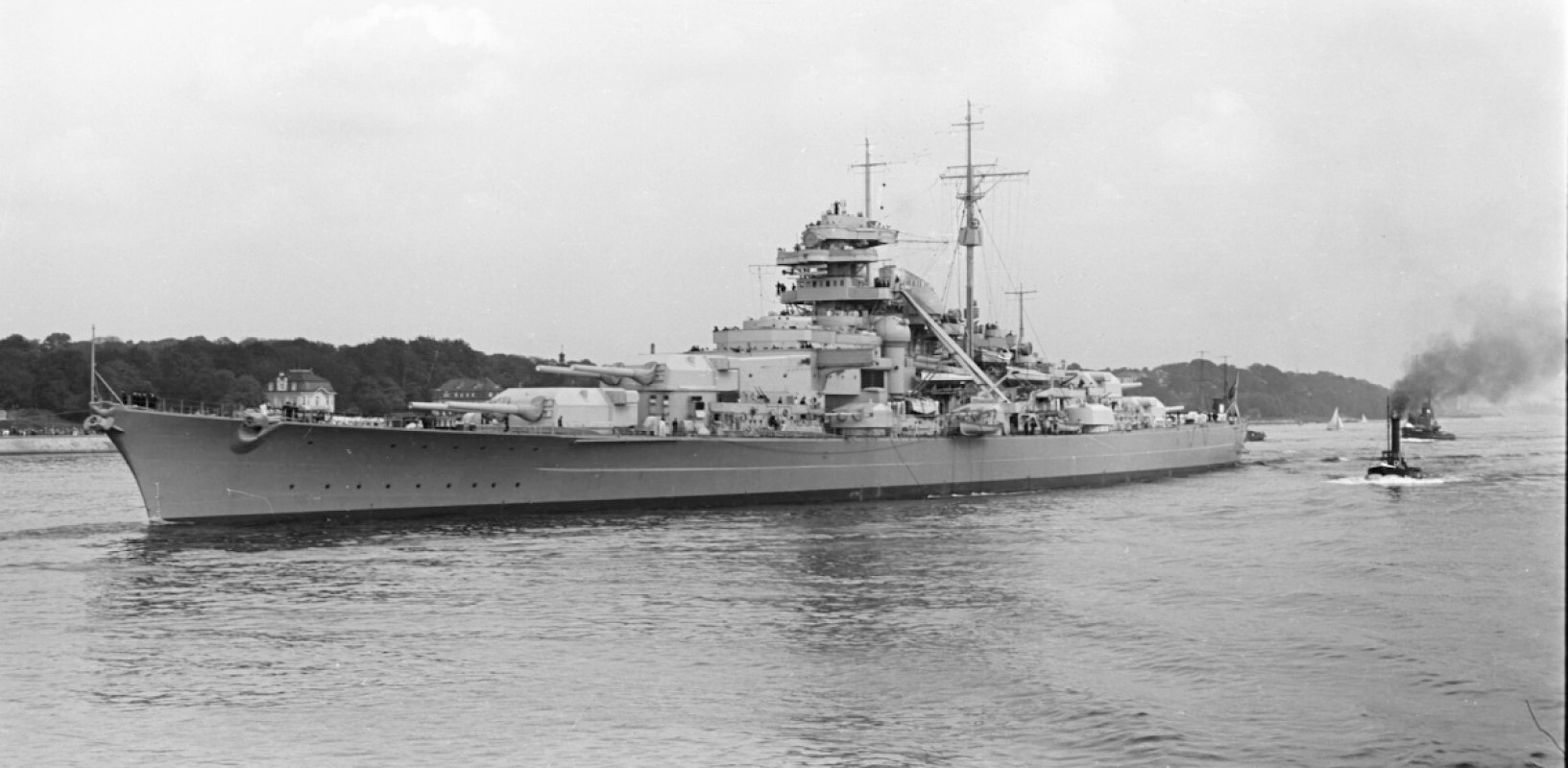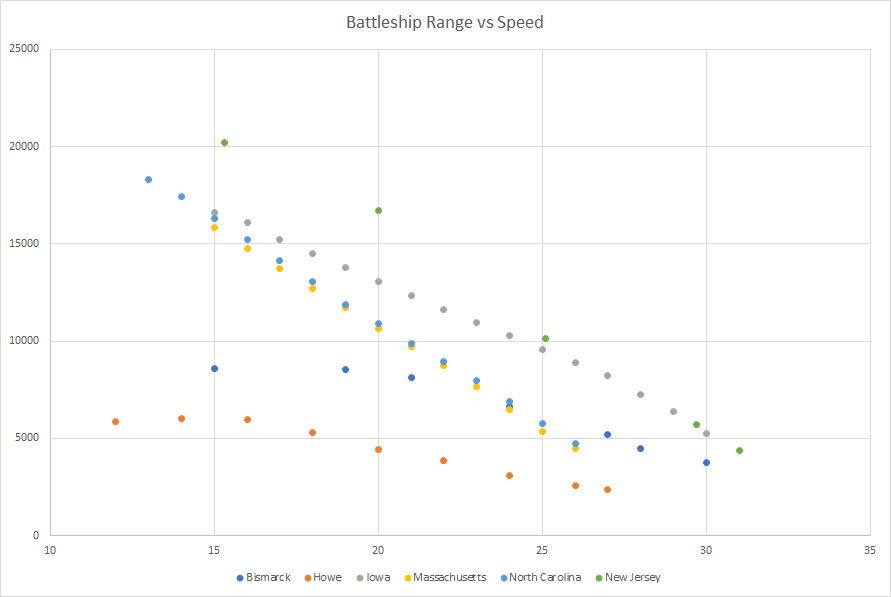While working on my section on Bismarck, I decided to look more deeply into the details of battleship range and the impact it had on designs. It's undoubtedly the most important obscure figure in battleship design, with many references not including it because the values available are so variable. Unfortunately, I quickly ran into a mess. A surprising number of ships I looked at, even in quite comprehensive sources, had only 2 or maybe 3 data points, spaced widely enough that it wasn't really possible to get a good sense of the shape of the curve involved.

The culprit behind all of this
In the end, I had only five reasonably good sources of data on the treaty battleships: data on Bismark spread across two books, Raven and Roberts with Howe and FTP 218 covering the American battleships, along with a report on trial results from Iowa and New Jersey.1 Only the last actually had speed, fuel consumption and power in the same place and without suspicion that there was significant rounding involved in the data I was seeing. And when plotted, the numbers for the American ships were reasonably consistent, both between the two sources and between different classes, although while they were all around 15,000 nm at 15 kts, Iowa had an advantage at higher speeds thanks to her longer hull. But the same was not true of the curves for the European ships, which were much shallower. Bismarck in particular went from having approximately half the endurance of the American ships at 15 kts to about the same endurance as the SoDak/North Carolina at 24 kts, and more above that.
There could be several factors behind this. It's possible that the different hull forms are optimized for different speeds, although a quick check of this suggests that it shouldn't look the way it does, as Bismarck has a significantly lower block coefficient than any of the other ships, while Howe has the highest of any of the ships involved. It's more likely that this is down to differences in machinery, although this is again confusing considering that Howe had the mildest steam conditions, then the American ships, then Bismarck. The only similarity between the two I can think of is the use of single reduction gears, which meant that while Bismarck's turbines were geared down about 10:1, the turbines of the Iowas had about twice that reduction.2 Turbines like to turn fast, and the low reduction on Bismarck could meant that her system was forced to operate at unfavorable speeds while going significantly faster than the American ships.

And all of this assumes that my numbers are being generated in a reasonably comparable manner, which probably isn't true. In particular, there's separation between the endurance values from the New Jersey trials data and the data from FTP 218 at low speed, while the two sets converge at high speed. This is probably because the data in FTP 218 was gathered in wartime, which is going to mean greater hotel loads (stuff like electrical power that is going to take steam from the boilers but not put out shaft horsepower) and keeping more of the boilers lit in case they need a lot of power quickly, which makes steam production less efficient.3 I have no clue how this played out for the other navies involved, or how their trials were run.
I started down this particular rabbit hole in the hopes of getting a better idea of how much range requirements impacted the rest of a battleship design after seeing an early sketch for what led to Bismarck that was quite weak for 35,000 tons, largely because it had a range of 16,000 nm at 19 kts. Initially I guessed this was about 60% greater than the American requirement (15,000 nm at 15 kts), but the much flatter curve makes this hard to compare directly. More broadly, I was hoping that there was some way to standardize all of the various range values in different references and get a consistent set of data for the book I'm working on. That doesn't seem possible, even leaving aside the issue that some ships have wildly different range values reported which probably reflects different use of emergency fuel tanks.
In the end, I wasn't really able to make anything of this, and I'm writing this up in case I come back to this in the future, or if anyone else has the same idea. And because I did the work and might as well get a blog post out of it.
1 Note that Iowa was using DFM instead of bunker oil in the 1985 trials, so range numbers aren't directly comparable. Note also that the naval architect who set up the 1985 trials had some doubts about the 1943 trials, but they should be good enough for our purposes. He also noted that the crew during the 1985 trial wasn't particularly experienced, which is important for getting the best out of a steam plant. As such, I've relied more on the 1943 numbers. ⇑
2 I checked around for information on the King George V, but wasn't able to find information on the gearing reduction in any of the obvious places, and didn't want to go through every obscure place it might be because that would take a long time. ⇑
3 It takes an hour or so to bring a boiler from cold to the point it can start producing power. In theory, an Iowa can cruise at 15 kts on a single boiler, but even in peacetime the lack of redundancy makes people nervous, and two is the usual setup for cruising, which also lets them get up to ~22 kts. Wartime will involve keeping at least four lit, with a top speed of 27 kts or so, and possibly all eight. ⇑

Comments
Very interesting, and that linked article by the Naval Architect was really fascinating!!
Thanks for doing this. I tried the same thing, but only had terrible wikipedia stats to work with and didn't get anywhere.
Engines and especially transmission get so little attention compared to the big shooty bits...
Yikes. That sounds extremely annoying, given that the vast majority of sources give one or maybe two speed/range figures, and don't worry too much about making sure they're consistent.
Huh... Makes me wonder how admirals and captains planned around this, if there weren't documented speed/range curves. Do you think they used data that just hasn't made it into reference sources? Or was it just something captains got a feel for?
They had data that hasn't made it into references. FTP 218 is probably more comprehensive than most, but I'm sure other navies had similar documents. The problem is that they're either entirely lost or in the bottom of archives where nobody has fished them out yet.
I wonder whether you could interpolate the curves using a multiphysics simulation.
Maybe if I had a couple PhDs in naval architecture and steam engineering. Looked into trying something like that a bit, and the problem is that the power/speed curve and the power/fuel efficiency curve are both quite complicated.
Tangential, but do you know what the gearing ratio destroyers was? The Sumners look to have had a very complicated set of cruising and regular turbines with ratios of up to 29:1.
Sumrall's book on the Sumner-Gearing classes says 16.26:1 for the high-pressure turbines and 13.69:1 for the low-pressure turbines. He doesn't mention the ratio for the cruising turbines, but it was probably somewhere in the area, as the cruising turbines generally were intended to spin a lot faster at a given speed. (Also weird that they were using cruising turbines that late. Didn't realize that was a thing in WWII.) The reduction ratios for the Fletchers should be slightly lower, as they used basically the same turbines but a prop that spun at 397 rpm instead of 350 rpm for the Sumner/Gearing.
I really want to dig into cruising turbines and figure it all out. It sounds like the US went really hard on giving their destroyers cruiser legs, especially during the 30s when it was obvious they'd be working in the pacific.
Would love to see European vs American destroyer machinery side by side.
http://www.hazegray.org/navhist/canada/systems/propulsion/y100/y100.pdf
This was an interesting look at the details of a post-war concept.
The introduction to FTP 218 explicitly confirms that fuel consumption is higher in wartime because peacetime-standard efficiency measures such as shutting down not-currently-needed boilers are not safe when you might be suddenly attacked, and says it was created because this difference had been a problem for planning.
Values are also given for fuel consumption while stationary, and the one for an Iowa roughly matches the above difference between the 1940s and 1980s low-speed data.
FTP 218 also notes that on some ships (including Iowas), filling the tanks all the way reduces damage resistance by enough that it is generally not recommended.
That's also weird because the usual reason for a battleship to weigh 35,000 tons doesn't count fuel. Unless they were planning to "lose" that sketch and say they had 16,000 nm range when they'd actually used the extra weight for something else...or were actually (also) hitting some other limit such as what would fit in their docks/canals/etc.
@echo: FTP 218 does also include data for destroyers, cruisers and carriers.
The fuel itself may not count, but the tanks still do, and when you're pushing that kind of range, it starts to have a very serious impact.
ww2 fuel consumption US Navy
https://www.ibiblio.org/hyperwar/USN/ref/Fuel/index.html#contents
I hate to ask silly questions, but what does FTP stand for?
Here, presumably Fleet Training Publication, the series of documents this belongs to.
(You may also find it used to refer to follow-the-pointer fire control.)
Few technical questions
How much steam one M-type boiler can produce at what fuel oil consumption.
How much fuel one M-type boiler and its auxilliaries are requiring being hot but not producing steam for propulsion?
Are the auxiliaries steam driven or use E-energy?
These questions will you lead you directly to the question wheter your powerplant is more efficient at low ship speed or not.
@Thoddy: the trials report linked above might be a good place to look.
Per FTP 218, an Iowa sitting still but at wartime readiness uses ~1/30 as much fuel as at full power. I suspect that's mostly heat loss from the boilers, rather than actual power use (radar, etc), but I don't have proof of that.
It varies, though either way they're driven by separate turbines, not off the main drive.
The way how Hotel loads were included in the range calculation, the calorific heating quality of fuel oil used and the amount of reserves included / excluded make up for most of the difference encountered here.
Can you expand on that? I could see hotel loads changing the slope of the curve some (and indeed we see this with Iowa v New Jersey) but the hotel load would need to be outrageously large for Iowa v Bismarck, and I would expect the Iowa curve to have about the biggest hotel load of any of the ships involved. Changes in the calorific value of the oil should just shift the curve up or down, again doing nothing to explain the different slopes, and the same is true of reserves.
Edit: On reflection, calorific changes would change the curve slope, but you'd need to double the calorific values of Howe's oil to get it more or less match SoDak. And Bismarck is clearly in an area where none of these even remotely explain what's going on. And the same might technically be true of reserves, but again, the values involved would have to be completely outrageous to make the curves look like this